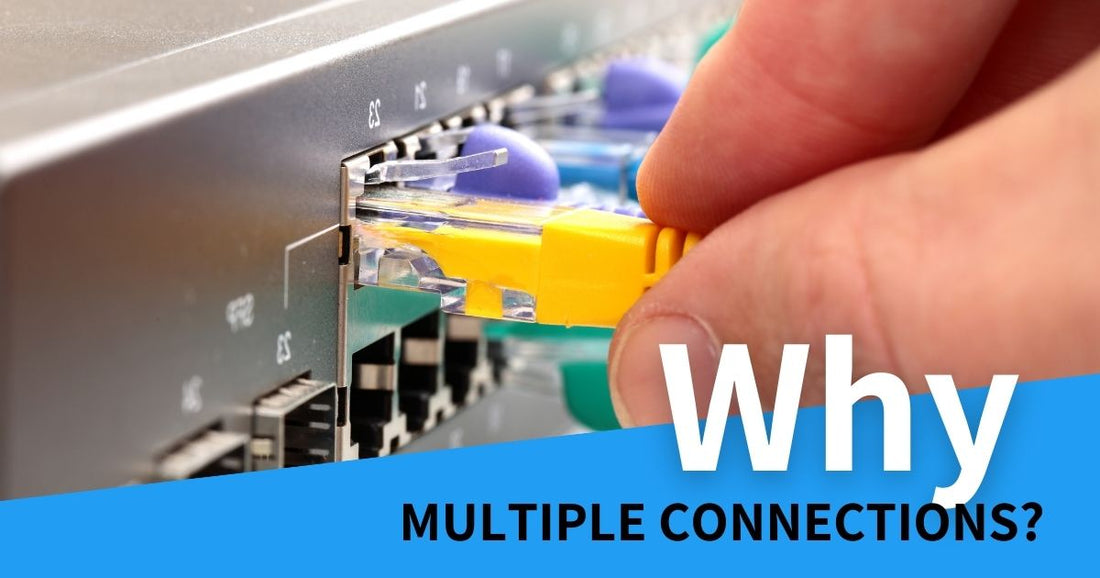Fast business internet using multiple connections

The internet is the bloodstream of many businesses. Loss of internet or temporary downtime can have a detrimental impact even on brick and mortar businesses like retail stores – point of sale software and terminal problems can, in many cases, lead to lost income. So, the question is, how do you combat these issues? You want to look to implement a failover option.
The lack of a "backup plan" is not the only problem. Overloading one single WAN link or a server can cause a connection failure and also decreased bandwidth.
Multiple Connections and Load Balancing
Load Balancing Routers
One way you can eliminate concerns is by introducing a load balancing router. Imagine the office of a small business. Employees are emailing, downloading files, browsing the web, talking internationally using VoIP, video streaming and more. Whilst all of these operations could be easily supported by a 2Mb/s ADSL connection, the problem occurs when all of them are carried out simultaneously.
That’s where a load balancing router is useful. A load balancing router’s job is to make sure that two or more broadband internet connections are shared among different users. At this point, it is worth mentioning that this method of load balancing is not to be confused with link aggregation or server-side load balancing. A load balancing router does not bundle nor aggregate multiple network connections. For example, it’s not able to create one 400Mb/s throughput from four 100Mb/s connections. Their primary function is to improve the overall experience of different users and provide redundancy in case a single connection goes down.
There are many benefits of using a load balancing router. Let’s take a look at some of them.
Bandwidth
The most important would be making more bandwidth available to every user. Time is money as they say. In the digital business world, however, time also equals internet connection speed. So, if your staff are hanging around waiting for a page to load instead of being fully operational, you’re losing time and money.
Reliability
We’ve already discussed the consequences of downtime and connection losses, with load balancing you have a dual or multi-WAN connection, meaning that if any of the connections fail, the traffic is rerouted to the remaining ones.
Cost
Until several years ago, one of the problems associated with load balancing was the cost of putting it into effect. Today these solutions are much more affordable. Although other benefits are inherent, the deciding factor for your business may be the cost. Think about how much time and money may be lost when the internet is down, and then ask yourself whether the money for a loading balancing solution is worth it.
Security
Load balancers are also excellent for increasing network security. They can selectively prevent traffic forwarding by configuring an access list and then filtering packets of data in accordance with this list (users, computers and groups for example). Any entry not included on the access list will be denied access. This is a good way of increasing intrusions into a local network.
Business with multuple connection to the internet via 3 different ISPs
Link Aggregation
In computer networking, the term link aggregation applies to various methods of bundling two or more parallel Ethernet interfaces into one logical point-to-point link.
But how is this practice supposed to help your business network improve?
Well essentially, pretty much the same way load balancers do. The main difference is that link aggregation actually produces one super-fast virtual channel from multiple Ethernet links. That way you get overall data throughput equal to multiples of a single Ethernet link’s speed.
Backbone network capacity and cost effectiveness
Backbone is a network component that provides the path for data exchange among multiple LANs or subnetworks within an organisation. These organisations operate in several offices in a building, within a campus, or over a wider area.
Link aggregation is a low-cost solution for setting up a backbone network capable of transferring large amounts of data. It also allows you to increase your backbone capacity as demand on the network grows. This is an effective, yet affordable option since it allows you to enhance your network performance without buying faster hardware.
Commonly, when establishing a backbone network, technicians install more cabling or fibre optic pairs than is necessary at first. This is done because the labour cost is much higher than the cost of cables. When applying link aggregation, you can use these additional cables to increase backbone speed for little to no extra cost.
Redundancy and fast convergence
Not only does link aggregation increase throughput and bandwidth, but also adds redundancy to your network. If a single Ethernet link fails, an automatic recovery feature redistributes the load across the remaining links in less than a second. The end user is unaware of this convergence - no host protocol timers expire, and hence no sessions are interrupted.
No matter how large your business is and regardless of the industry, it’s vital that your customers don’t worry about possible failure. It’s crucial that your VoIP call is not interrupted in the middle of the conversation with your colleague or valued customer. Your business can’t afford to lose the edge on competing with others.
If a slow internet connection and frequent downtimes prevent you from adhering to these principles, consider implementing some of the methods discussed above. To achieve 100% customer satisfaction as well as full internal functionality think about how your business would suffer if you lost communications and customers could not contact you. This type of disaster recovery planning can help you travel a long distance on the path to the next level of growth.

